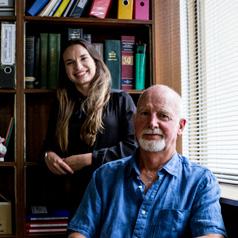
3 minute read
Counting the cost
In 2009, British army reservist Tia Cummins wondered amid the yelling and screaming of a bayonet training exercise if the ramped-up aggression was the best approach.
Tia, who’d been an army cadet since she was 14, was studying psychology at university at the time of the bayonet exercise. She tested her question about aggression in her final year studies, finding that soldiers who acted more aggressively in a military shooting drill had a faster reaction time but that they were not always more accurate.
This finding led to a fascination with military research and later the long-term effects of combat on the brains of veterans, the ‘cognitive casualties’ of war. Eight years later, Tia has completed a PhD at the Florey, discovering links between military veterans with traumatic brain injury (TBI), post-traumatic stress disorder (PTSD) and dementia.

A member of Professor Christopher Rowe’s laboratory, Tia has collated data from a five-year study into veterans and Alzheimer’s disease – a world-first in the field.
Studies had previously suggested that veterans with PTSD and TBI were more at risk of developing Alzheimer’s disease in later life than civilians. However, the mechanism in the brain that might be involved was never understood, and there were yet other studies that disputed the idea.
Collaborating with the University of California, San Francisco, and Austin Health, the Florey researchers recruited 127 Australian Vietnam war veterans aged 60 to 85 years, dividing them into three groups: those who had PTSD, TBI acquired in service in their early 20s, and a healthy control group. The men had full psychiatric assessments and cognitive tests for memory and attention. Their brains were scanned for two proteins that are the hallmarks of Alzheimer’s – amyloid plaques and tau tangles. The scientists tested brain metabolism “to see if brain cells were firing correctly” and took blood tests for genetic dementia risk.
They used magnetic resonance imaging (MRI) to look at brain structure and function, checking for any shrinkage in grey matter that would indicate Alzheimer’s and for small tissue tears in the white matter of brains of the veterans with TBI.
“White matter is the ‘wiring’ connecting brain cells to each other and to the rest of the brain,” says Tia. “Specifically, we were looking for tears in the corpus callosum, which connects the two hemispheres of the brain, the part most at risk of damage due to head injury,” she says.
The Florey thanks Michael Ingram *, 71, who is one of 127 Vietnam veterans, many with PTSD, who volunteered to be part of Tia’s research.
Michael received severe head injuries when he was 21 in 1969 when a rocket grenade hit the tank he was driving. Half a century later, Michael knows that when he’s tired or run down, the PTSD is likely to reappear. “My secret to beating it is to keep my mind and body active,” says the retired landscape gardener.
“I’ve been really happy to be part of Tia’s research. I’ll do all I can to help the guys coming home now from war,” Michael says.
* Our cover photo shows Michael in our CT scanner.
The veterans’ head injuries ranged from being shot through the head, blast exposure and motor vehicle accidents to non-combat-related injuries sustained playing football in Vietnam. The findings have been revealing – with mixed news for veterans.
“We’re not finding the proteins associated with Alzheimer’s disease. We haven’t left any stone unturned – we looked extensively for those proteins but we’re not seeing them.”
Cognitive casualty
More surprising for Tia was the data from the TBI group, which showed that those who’d sustained moderate and severe head injuries during their army service did have thinking and memory problems, but that these did not appear related to the dementia process.
“It looks like they were from the time of injury from the actual impact, things they’ve actually had to cope with and live with. Somehow, they have been able to compensate for the injury,” she says. “It shows how well these guys have learnt to adapt.”
The study collated data on the men’s health more broadly, identifying a range of physical, psychiatric and psychological issues. “Overall, it suggests that the cost of military service lasts a lifetime but doesn’t necessarily increase risk for dementia. Many of the health issues we are seeing in this group of veterans, 50 years after their service, are preventable and I think it enforces the need to spend more on looking after troops as soon as they get back from Iraq or Afghanistan to address what could become lifelong issues.”
Tia is passionate about raising awareness around the long-term effects of combat on veterans, speaking at the RSL and conferences here and overseas, spreading the word about what she calls the invisible wounds of war.
The study was partly funded by the US Department of Defense.
Tia shares with us her favourite book “Madness, A Memoir” by Kate Richards Richards is a very talented author who is able to guide the reader through a very difficult and stigmatised psychiatric illness with elegance and poise. Very rarely are real life stories of mental illness communicated so well, and think Richards allows the reader to almost experience what it is like to live with such an illness.
Following the ‘call to arms’ for people living with MND to donate skin cells, Neale was the first to volunteer at Calvary Health Care Bethlehem. Neale is one of many people from Victoria and around Australia who have come to Melbourne to donate cells at Calvary Healthcare. The cells are transported to the Florey’s MND laboratory, run by Associate Professor Brad Turner, where our work begins.








